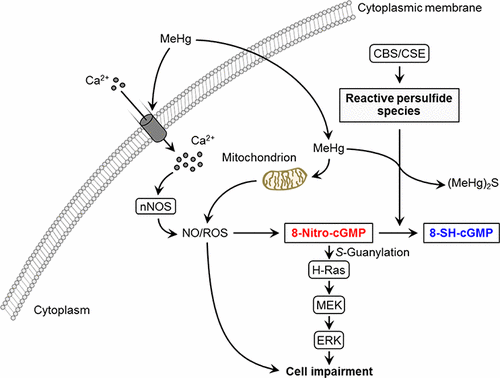当前位置:
X-MOL 学术
›
Chem. Res. Toxicol.
›
论文详情
Our official English website, www.x-mol.net, welcomes your feedback! (Note: you will need to create a separate account there.)
Exposure to Electrophiles Impairs Reactive Persulfide-Dependent Redox Signaling in Neuronal Cells
Chemical Research in Toxicology ( IF 4.1 ) Pub Date : 2017-09-07 00:00:00 , DOI: 10.1021/acs.chemrestox.7b00120 Hideshi Ihara 1 , Shingo Kasamatsu 1, 2 , Atsushi Kitamura 1 , Akira Nishimura 2 , Hiroyasu Tsutsuki 3 , Tomoaki Ida 2 , Kento Ishizaki 1 , Takashi Toyama 4 , Eiko Yoshida 4 , Hisyam Abdul Hamid 2, 5 , Minkyung Jung 2 , Tetsuro Matsunaga 2 , Shigemoto Fujii 2 , Tomohiro Sawa 3 , Motohiro Nishida 6 , Yoshito Kumagai 4 , Takaaki Akaike 2
Chemical Research in Toxicology ( IF 4.1 ) Pub Date : 2017-09-07 00:00:00 , DOI: 10.1021/acs.chemrestox.7b00120 Hideshi Ihara 1 , Shingo Kasamatsu 1, 2 , Atsushi Kitamura 1 , Akira Nishimura 2 , Hiroyasu Tsutsuki 3 , Tomoaki Ida 2 , Kento Ishizaki 1 , Takashi Toyama 4 , Eiko Yoshida 4 , Hisyam Abdul Hamid 2, 5 , Minkyung Jung 2 , Tetsuro Matsunaga 2 , Shigemoto Fujii 2 , Tomohiro Sawa 3 , Motohiro Nishida 6 , Yoshito Kumagai 4 , Takaaki Akaike 2
Affiliation

|
Electrophiles such as methylmercury (MeHg) affect cellular functions by covalent modification with endogenous thiols. Reactive persulfide species were recently reported to mediate antioxidant responses and redox signaling because of their strong nucleophilicity. In this study, we used MeHg as an environmental electrophile and found that exposure of cells to the exogenous electrophile elevated intracellular concentrations of the endogenous electrophilic molecule 8-nitroguanosine 3′,5′-cyclic monophosphate (8-nitro-cGMP), accompanied by depletion of reactive persulfide species and 8-SH-cGMP which is a metabolite of 8-nitro-cGMP. Exposure to MeHg also induced S-guanylation and activation of H-Ras followed by injury to cerebellar granule neurons. The electrophile-induced activation of redox signaling and the consequent cell damage were attenuated by pretreatment with a reactive persulfide species donor. In conclusion, exogenous electrophiles such as MeHg with strong electrophilicity impair the redox signaling regulatory mechanism, particularly of intracellular reactive persulfide species and therefore lead to cellular pathogenesis. Our results suggest that reactive persulfide species may be potential therapeutic targets for attenuating cell injury by electrophiles.
中文翻译:

暴露于亲电子试剂会损害神经元细胞中反应性过硫化物依赖性氧化还原信号的传导
诸如甲基汞(MeHg)之类的亲电试剂通过与内源性硫醇的共价修饰影响细胞功能。最近有报道称,反应性过硫化物具有较强的亲核性,可介导抗氧化反应和氧化还原信号。在这项研究中,我们将MeHg用作环境亲电试剂,发现细胞暴露于外源亲电试剂会提高内源亲电分子8-硝基鸟苷3',5'-环一磷酸(8-nitro-cGMP)的细胞内浓度反应性过硫化物质和作为8-硝基-cGMP代谢物的8-SH-cGMP的消耗。暴露于MeHg也会诱发S-鸟苷酸化和H-Ras活化,然后损伤小脑颗粒神经元。亲电试剂诱导的氧化还原信号激活和随后的细胞损伤通过用反应性过硫化物物质供体预处理而减弱。总之,具有强亲电性的外源亲电体(例如MeHg)会破坏氧化还原信号调节机制,特别是细胞内反应性过硫化物物种的氧化还原信号调节机制,因此导致细胞发病。我们的结果表明,反应性过硫化物可能是减轻亲电试剂对细胞损伤的潜在治疗靶标。
更新日期:2017-09-07
中文翻译:

暴露于亲电子试剂会损害神经元细胞中反应性过硫化物依赖性氧化还原信号的传导
诸如甲基汞(MeHg)之类的亲电试剂通过与内源性硫醇的共价修饰影响细胞功能。最近有报道称,反应性过硫化物具有较强的亲核性,可介导抗氧化反应和氧化还原信号。在这项研究中,我们将MeHg用作环境亲电试剂,发现细胞暴露于外源亲电试剂会提高内源亲电分子8-硝基鸟苷3',5'-环一磷酸(8-nitro-cGMP)的细胞内浓度反应性过硫化物质和作为8-硝基-cGMP代谢物的8-SH-cGMP的消耗。暴露于MeHg也会诱发S-鸟苷酸化和H-Ras活化,然后损伤小脑颗粒神经元。亲电试剂诱导的氧化还原信号激活和随后的细胞损伤通过用反应性过硫化物物质供体预处理而减弱。总之,具有强亲电性的外源亲电体(例如MeHg)会破坏氧化还原信号调节机制,特别是细胞内反应性过硫化物物种的氧化还原信号调节机制,因此导致细胞发病。我们的结果表明,反应性过硫化物可能是减轻亲电试剂对细胞损伤的潜在治疗靶标。



























 京公网安备 11010802027423号
京公网安备 11010802027423号